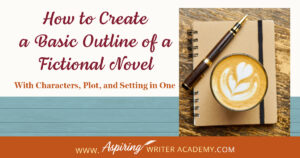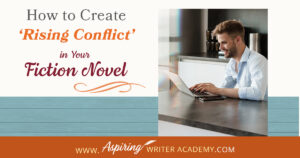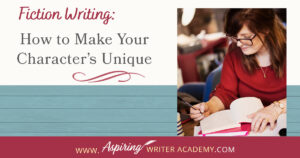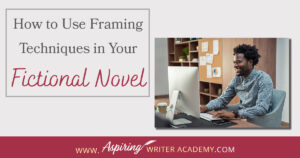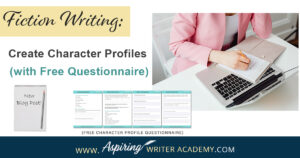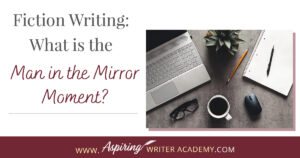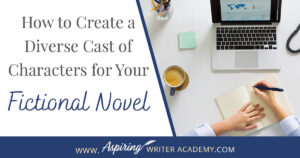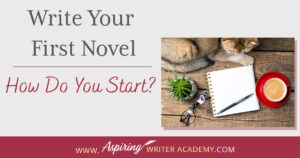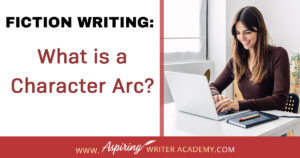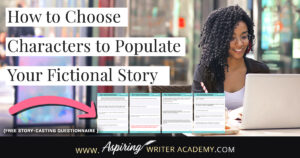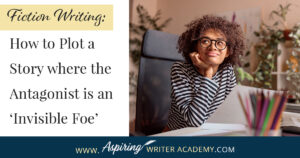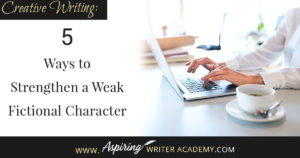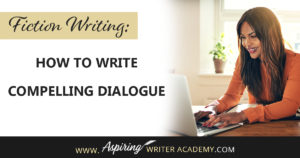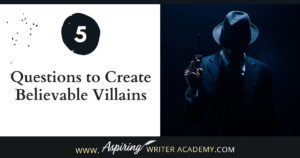Ready to bring your characters to life? Whether you're writing your first novel or your fifth, the Character Development section at Aspiring Writer Academy will help you create unforgettable protagonists, antagonists, and supporting cast members. We understand that characters are the heart of every great story—they can drive your plot, captivate your readers, and even become the reason they can’t put your book down. This page is filled with practical tips, creative exercises, and proven strategies to help you design characters with depth, purpose, and personality.
3 Tips: How to Switch Point-of-View When Writing Fiction
Have you heard the phrase “no head-hopping?” What does it really mean? Keeping your character’s point-of-view (POV) clear and consistent is key to making your story easy to follow. Plus, when you want to switch from one character’s perspective to another, it’s important to do it right! In 3 Tips: How to Switch Point-of-View When…
3 Steps: How to Create Fictional Characters with More Depth
Are you struggling to craft fictional characters that truly captivate your readers? Do some of your characters come across as “flat” or ordinary? How do you decide on their daily habits or explore their backstory? In what ways do other characters shape your protagonist’s growth?
In 3 Steps: How to Create Fictional Characters with More Depth, we help you go deeper into your characters’ development, background, timeline, and family history, so you can bring them to life in your fictional novel.
How to Create a Basic Outline of a Fictional Novel with Characters, Plot, and Setting in One
Looking for a faster, easier way to brainstorm a new story idea? Wondering where to begin—characters, plot, or setting? You can start with any of these elements, but it’s essential to consider how they interconnect, as adjustments may be necessary to craft a cohesive story that works.
How to Outline a Fictional Novel with Characters, Plot, and Setting in One Day offers a set of insightful questions designed to help you create a basic outline for your new fictional story—all in a single session.
How to Create ‘Rising Conflict’ in Your Fiction Novel
‘Rising Conflict’ in a fictional novel adds tension, moves the story forward, and helps create character change. But what exactly is rising conflict? Does every book need conflict? And what is the difference between internal and external conflict?
In How to Create ‘Rising Conflict’ in Your Fiction Novel, we address each of these questions and show you step-by-step how to create rising conflict at the scene and overall story level to write a riveting book your readers will love.
Fiction Writing: How to Make Your Character’s Unique
Do you struggle to create unique characters for your fictional novel? How do you let your reader know that your main character is a worthy hero? How do you reveal your character’s personality without telling or using dialogue?
In Fiction Writing: How to Make Your Character’s Unique, we discuss the use of body language, clothing, transportation, food, drink, mannerisms, speech, physical markings, and scents & smells to help you create unique characters your readers will love.
How to Use Framing Techniques in Your Fictional Novel
The term ‘Framing’ or using ‘Bookends’ refers to a technique in novel writing where the author creates similar passages at the start and finish of a story, or individual chapter or scene. Similar, but different. It is the tiny changes that give your story that exciting twist, satisfying closure, or added meaning.
In How to Use Framing Technique in Your Fictional Novel, we show you how to use framing on three levels to improve your writing skills, enhance your story, and thrill readers.
Fiction Writing: Create Character Profiles (with Free Questionnaire)
If you are planning to write a new story or need to add a character to your fiction novel, a handy fill-in-the-blank questionnaire can help define your character’s personality in a flash.
Beyond name, age, and hair color, our post, Fiction Writing: Create Character Profiles (with Free Questionnaire) helps you identify personality traits for your cast of characters that strengthen the story, intensify conflict, and enhance the plot.
How to Create a Fictional Character in 5 Steps
If you are just starting to write a novel, you may have come across character questionnaires to help you brainstorm basic information for your story cast, but how do you truly flesh out your characters on a deeper level? How do you make your characters jump off the page and feel “real?”
In How to Create a Fictional Character in 5 Steps, we give you more than just the average list of questions to think about so that you can create characters your readers will love.
Fiction Writing: What is the ‘Man in the Mirror Moment?’
Do you have a ‘man in the mirror moment’ in your fictional novel? Can you readily identify this pivotal moment in movies or other author’s fiction? Not only is it a turning point in the protagonist’s character arc, but it drives the external storyline forward during the second half of Act II.
In our post, Fiction Writing: What is the ‘Man in the Mirror Moment?’ we explain what this term means and how you can strategically use it to strengthen your entire novel.
How to Create a Diverse Cast of Characters for Your Fictional Novel
Have you read a book where all the characters sound the same and you have trouble remembering who is who? Without dialogue tags, would you know which fictional character is speaking? How can an author create characters that are unique?
In our post, How to Create a Diverse Cast of Characters for Your Fictional Novel, we show you how to intentionally design characters who contrast with one another in various ways to create additional conflict and raise the tension in the plot.
Write Your First Novel: How Do You Start?
Are you finally ready to write that book you always wanted to write one day? Great! How do you start? Who should be your main character? What will the story be about? Does there have to be a villain? When and where should the story take place?
In our post, Write Your First Novel: How Do You Start? we help you choose your main character, pinpoint the opposition, and create a story that you will be excited to write!
Fiction Writing: What is a Character Arc?
In the best stories, the protagonist (main character) undergoes change as he or she struggles to meet challenges, resolve conflict, and achieve the story goal. The character may overcome a weakness or have a change of heart or point of view, but he is not the same person at the end of the story as he was at the beginning. The story-journey changes him.
In our post Fiction Writing: What is a Character Arc? we help you create character change that is both incremental and believable.
How to Create Antagonists Who Are Not Villains
A good fictional story will follow the journey of a main character (protagonist) who is trying to achieve a specific goal. The opposition, (or antagonist), will try their best to stop the main character from achieving that goal. The question is why?
What if each point of view is equally valid? What if the antagonist is not a villain?
In our post, How to Create Antagonists Who Are Not Villains, we show you how to write realistic conflict that will intensify your fictional novel.
How to Create the Protagonist for Your Fictional Story
Are you interested in writing a novel but struggle with a story idea or how to develop your main character? What should your character look like? What factors should you consider when creating their personality? How does the story influence character and character influence story?
In our post, How to Create the Protagonist for Your Fictional Story, we lead you step-by-step in the development of a main character your readers will relate to, root for, and enjoy.
How to Choose Characters to Populate Your Fictional Story
When starting to write a novel, what do you do first? Create characters or a story idea? It’s kind of like the infamous chicken and the egg question. Starting either way can be fine. But at some point, you need to figure out—who are going to be the characters in this story?
In How to Choose Characters to Populate Your Fictional Story, we discuss the different roles characters can play to create a story readers will love. Free Story-Casting Questionnaire included.
Fiction Writing: How to Plot a Story where the Antagonist is an ‘Invisible Foe’
Plotting a fictional novel may seem easy when the antagonist your main character is fighting against is a formidable person or a savage shark or beast. But what if the opposition in your story is a force of nature like an approaching storm, or if the storm is within the mind of your main character, or perhaps in the shape of a horrific disease?
See how we break down the structure for such stories step by step in Fiction Writing: How to Plot a Story where the Antagonist is an ‘Invisible Foe’.
Creative Writing: 5 Ways to Strengthen a Weak Fictional Character
Do you have trouble writing strong fictional characters?
Perhaps you have been told that your protagonist or antagonist or a sub-character is weak, that they need more motivation. Perhaps the character doesn’t have a strong enough story goal, or enough personality or maybe the character isn’t actively driving the story forward.
How can you “fix” a weak character and make him worthy? Follow along as we discuss, Creative Writing: 5 Ways to Strengthen a Weak Fictional Character in the post below.
Fiction Writing: How to Write Compelling Dialogue
Have you ever read a book where the characters’ dialogue put you to sleep?
If you write fiction, this is not something that you want anyone to say about your stories!
In our post, Fiction Writing: How to Write Compelling Dialogue, we help you create riveting, lively exchanges between your fictional characters so that your book is filled with edge-of-your-seat tension and unexpected surprises for the reader.
5 Questions to Create Believable Villains
What is the difference between an antagonist and a villain? What motivates a villain to do heartless, hurtful, vindictive, terrible things? How can you bring the villain in your fictional story to life for your reader in an identifiable, believable, understandable way?
In our post, 5 Questions to Create Believable Villains, we explore the first questions you should ask when you start to brainstorm this type of character for your story.
Why Your Characters Need Story-Worthy Goals
Have you ever been told by an agent or editor, reviewer, critique partner, or reader that your writing was blah because your main character’s goal was weak, not strong enough, that it wasn’t ‘story-worthy?’
What does ‘story-worthy’ even mean?
In the post below, we will discuss what makes a goal story-worthy so that you can write engaging stories that hold your reader’s attention from beginning to end.
Fiction Writing: How to Name Your Cast of Characters
Choosing names for the characters in your fictional story can be done at random, like drawing names out of a hat, or purposely planned out to add greater depth and meaning to the tale you desire to tell.
Whichever method you choose, you may want to consider using our top 5 suggestions for Fiction Writing: How to Name Your Cast of Characters to make each name recognizable, distinguished, and easy to remember for both you and your readers.
10 Questions to Ask When Creating Characters for Your Story
You have decided that you want to delve into the world of fiction and write a story. Great! You even have an awesome story idea that you’ve been playing around with in your head. Great! Now…what kind of characters could be in a story like this? And most importantly, who will be the protagonist—the main character of your story?



